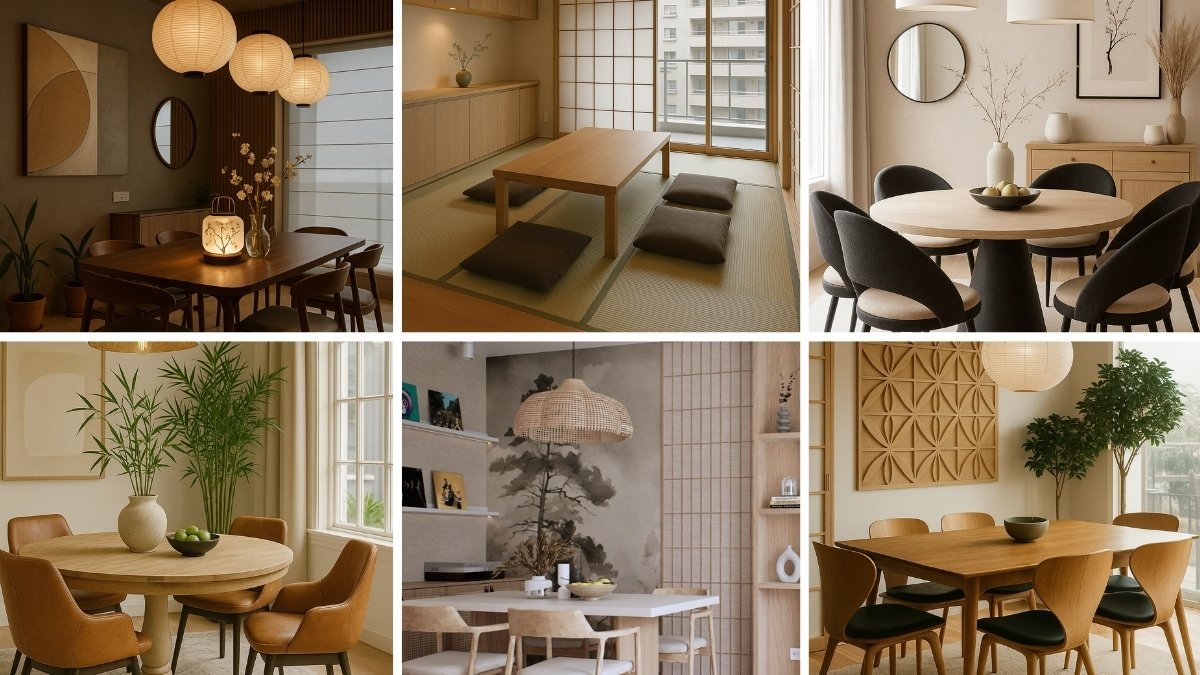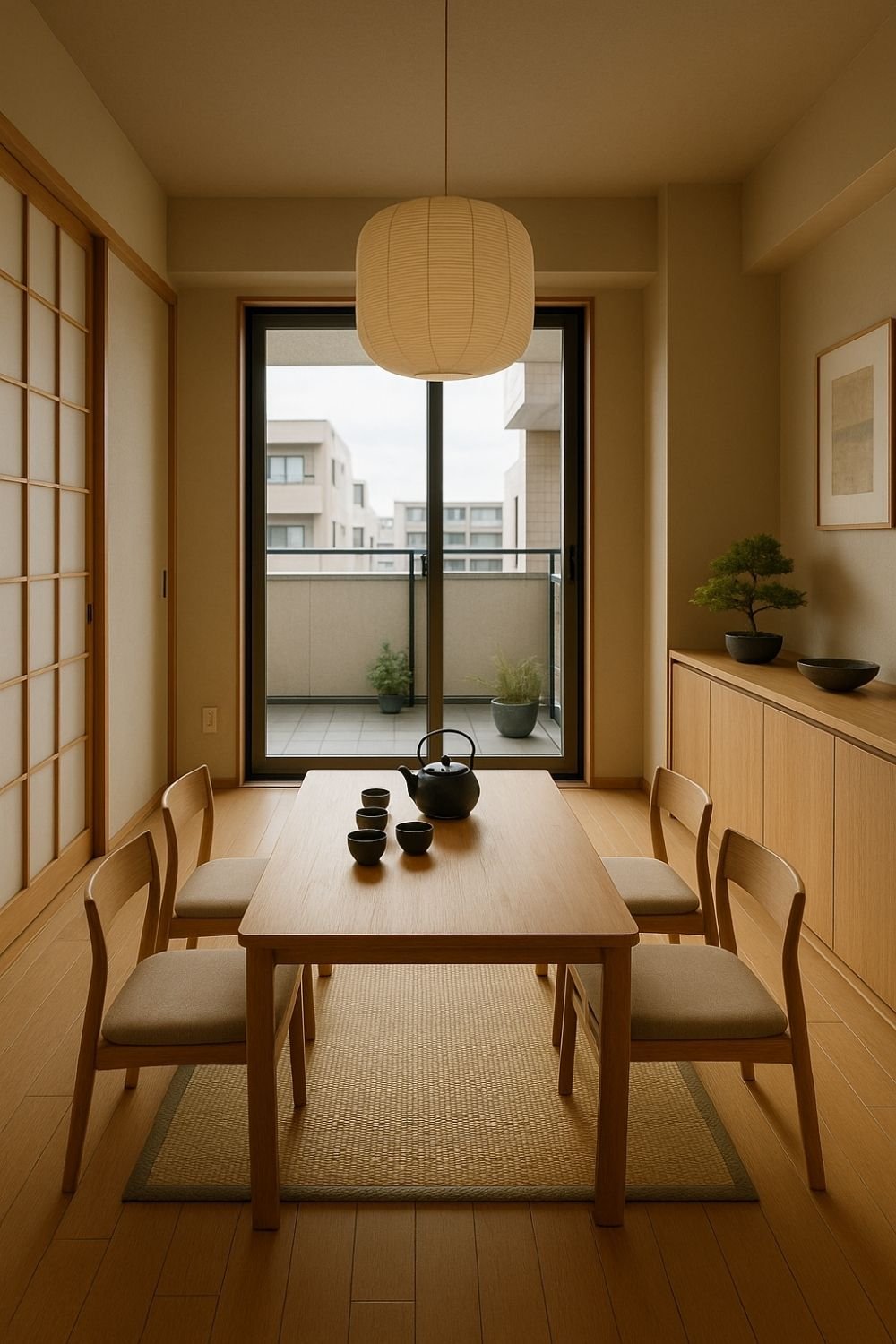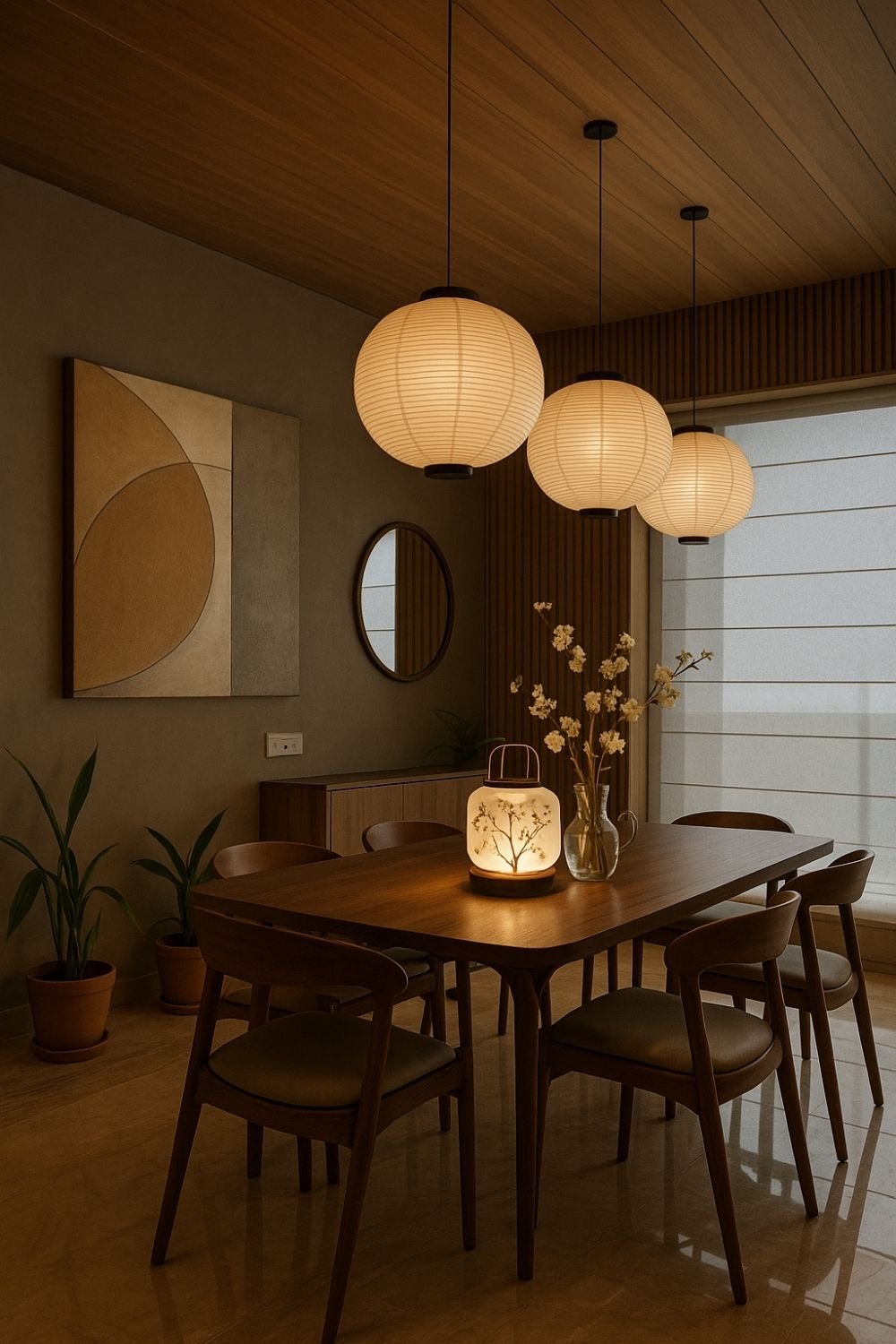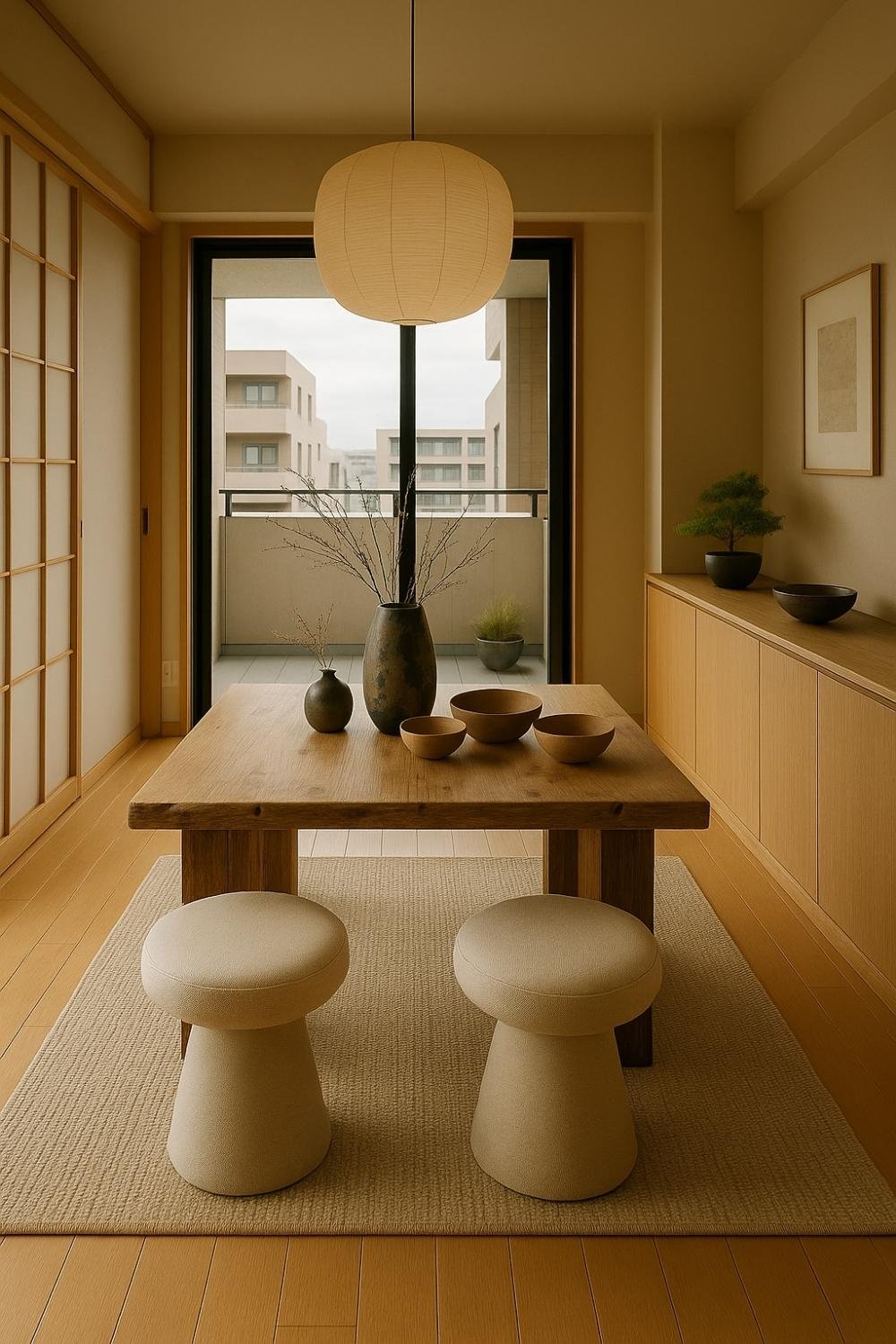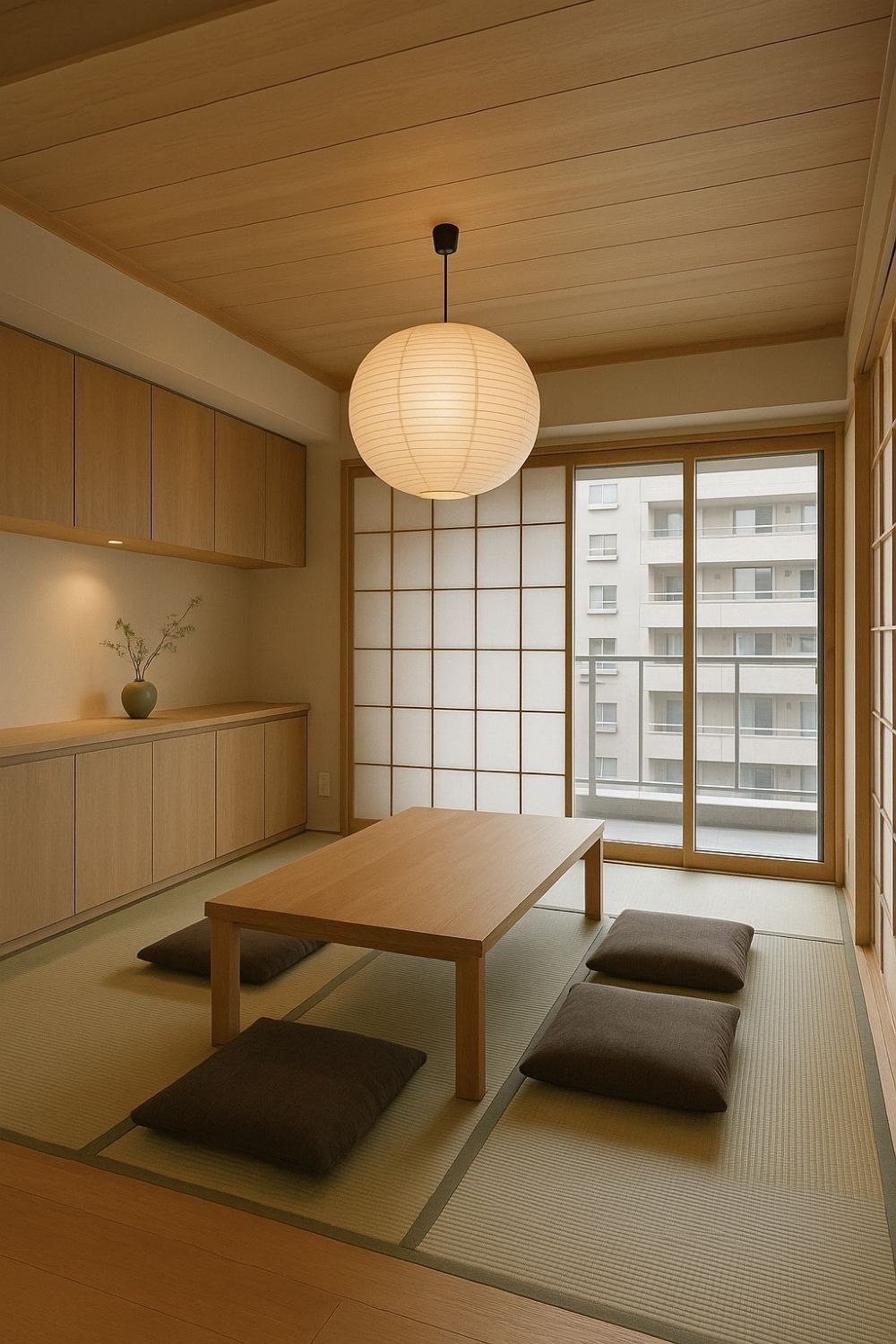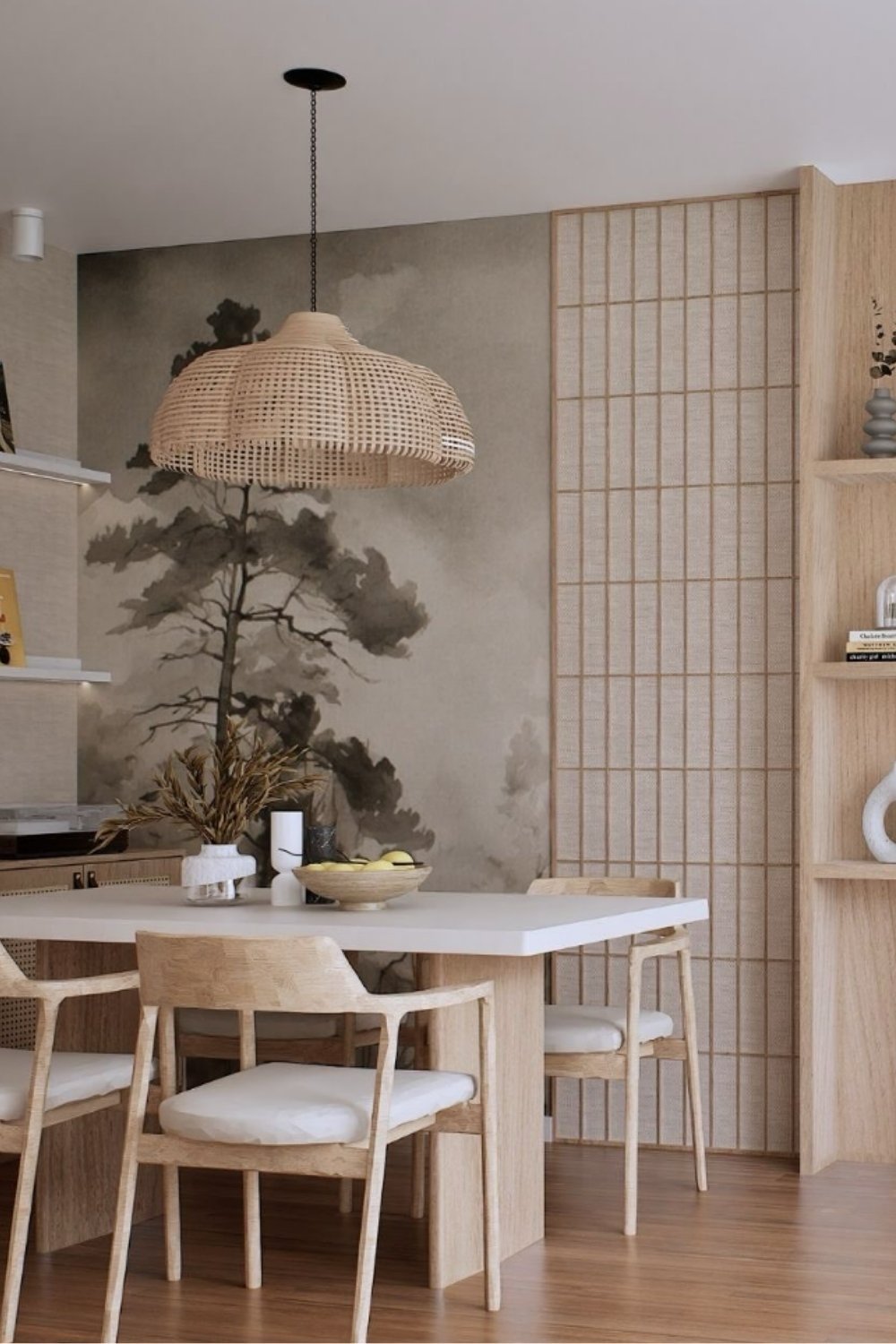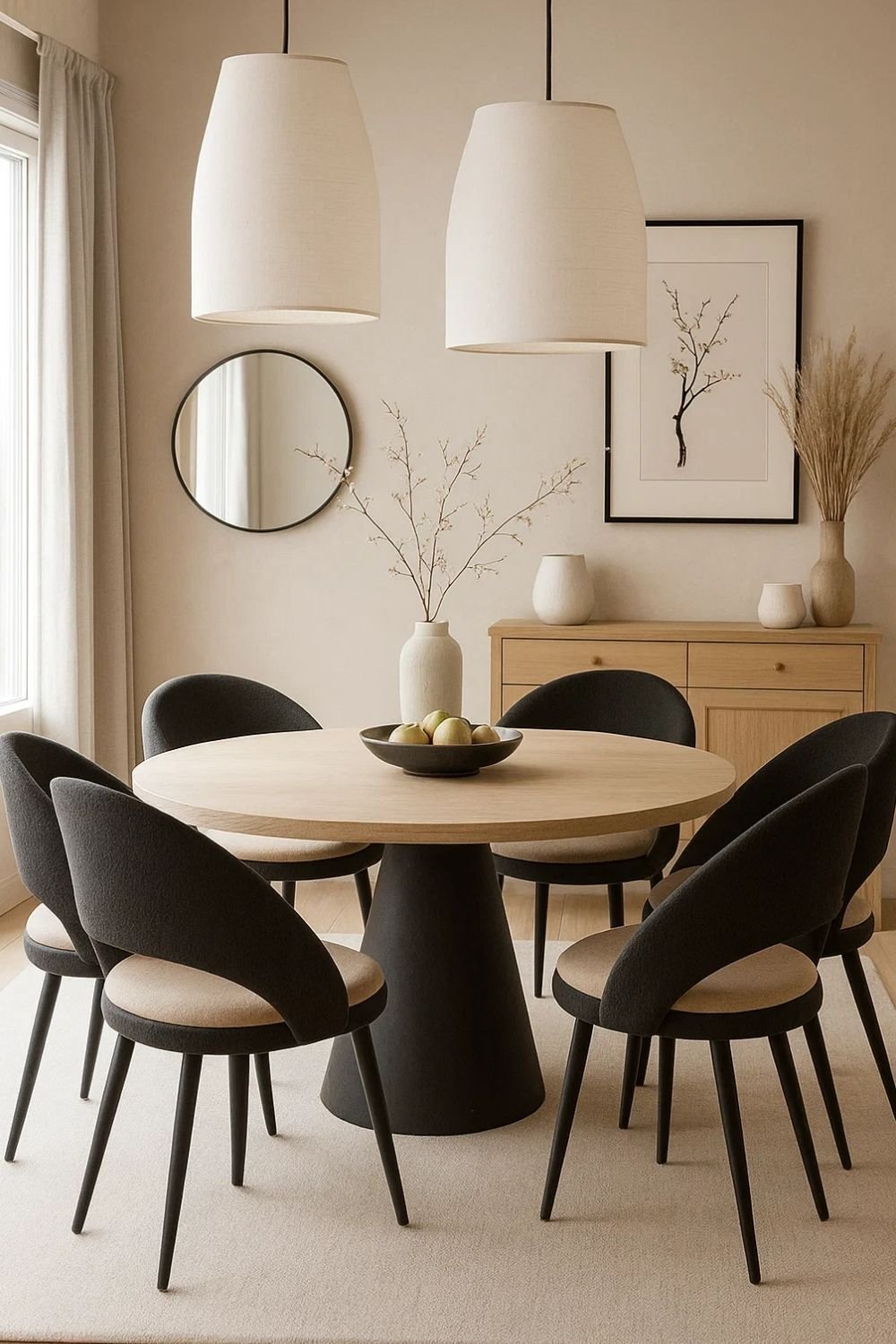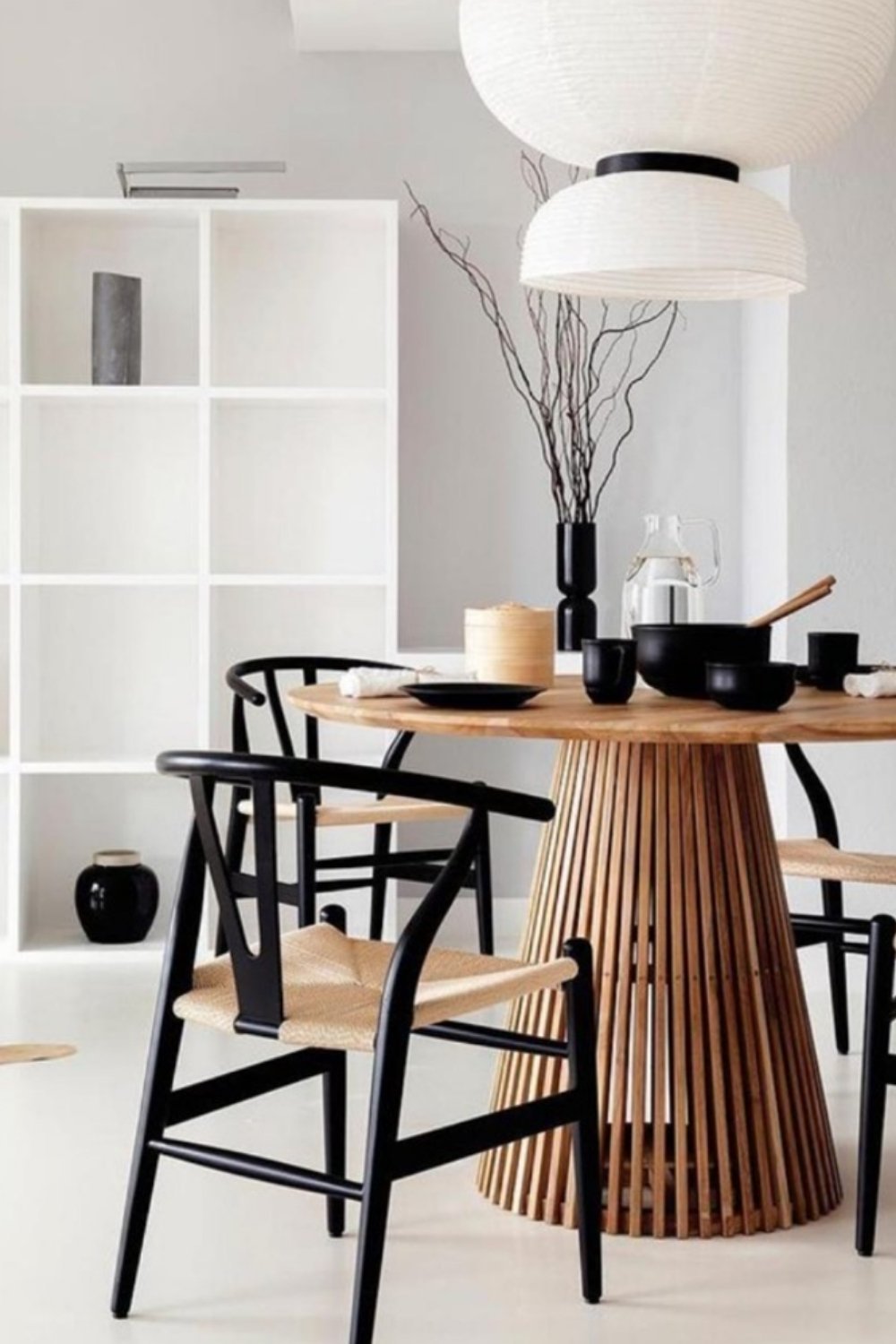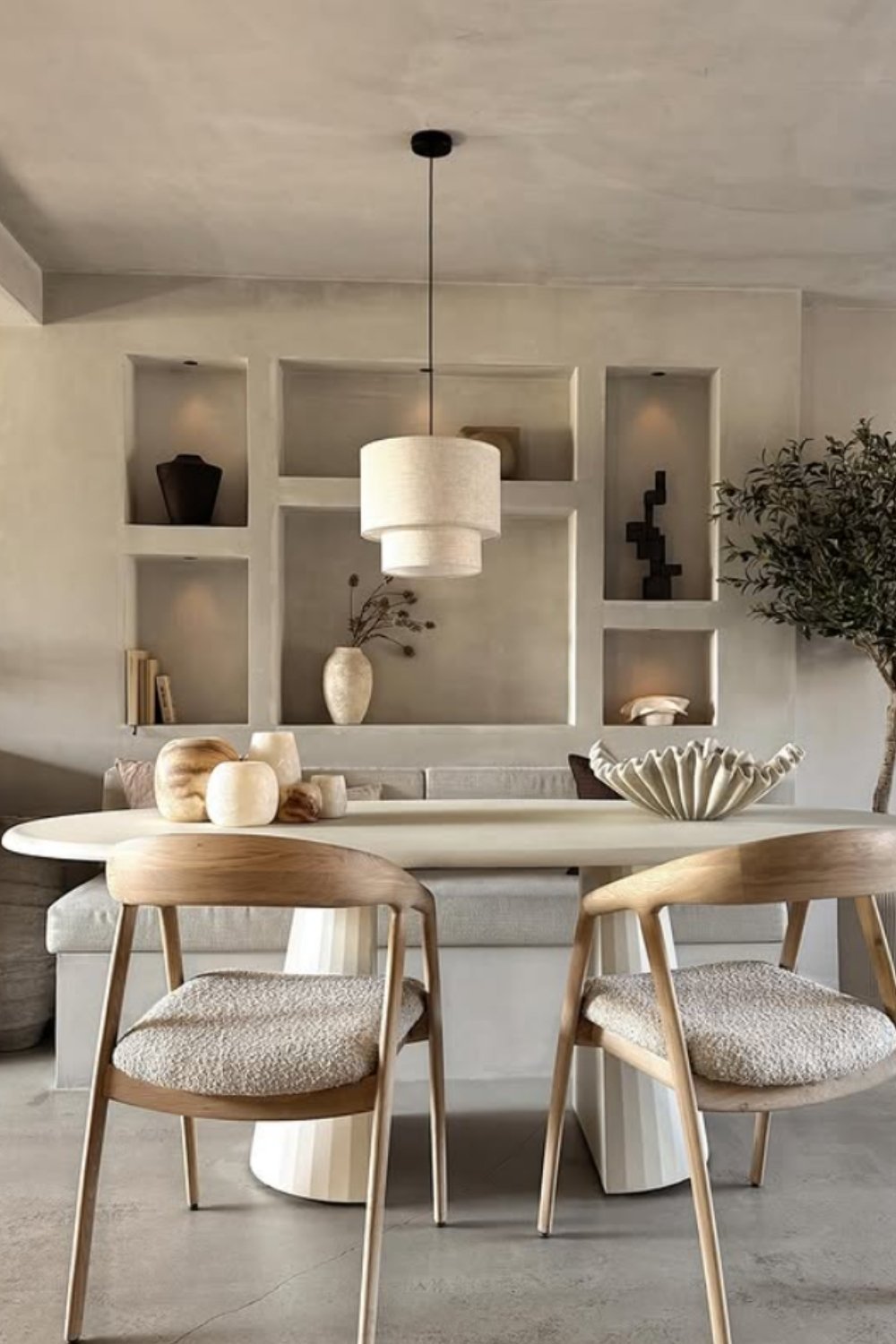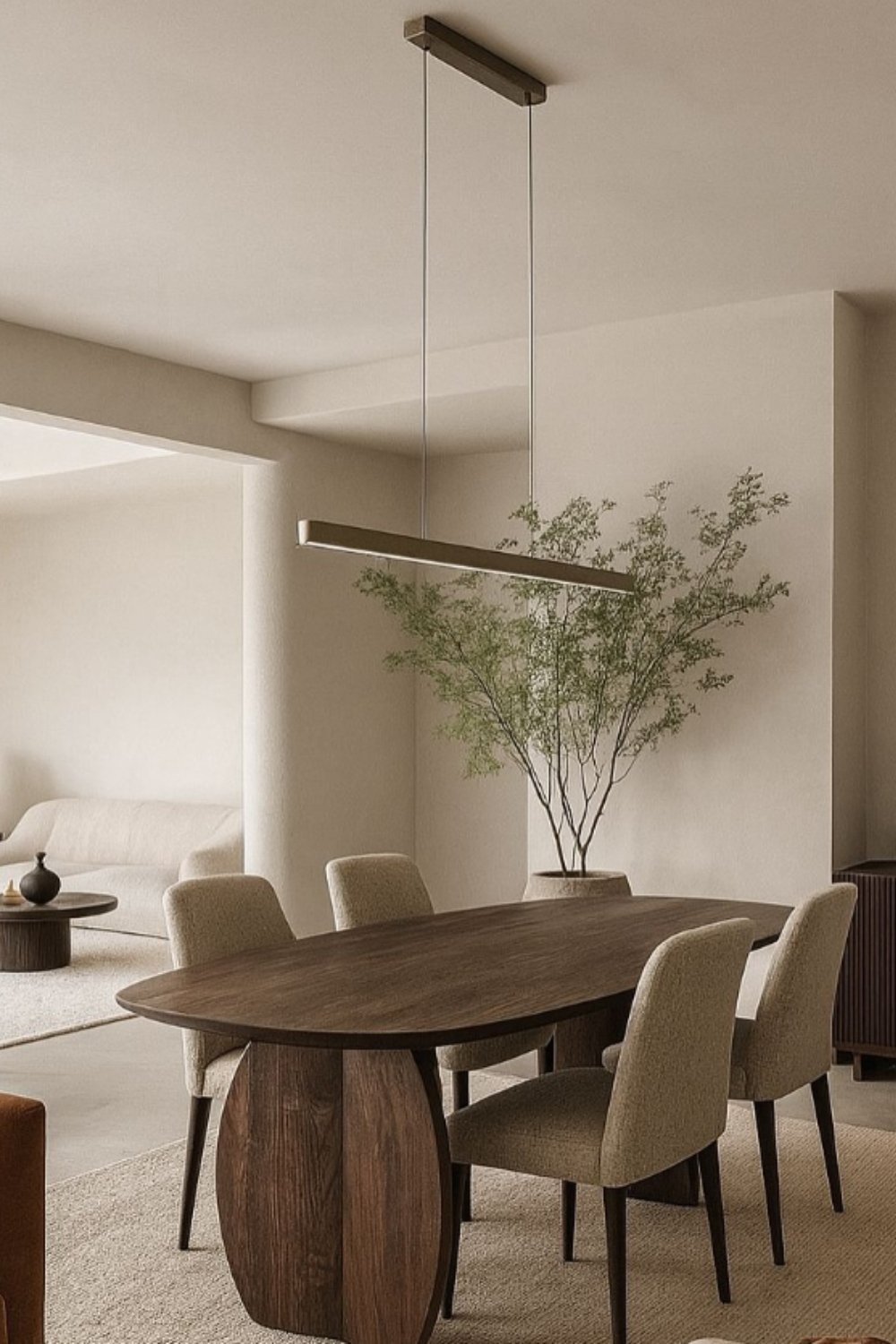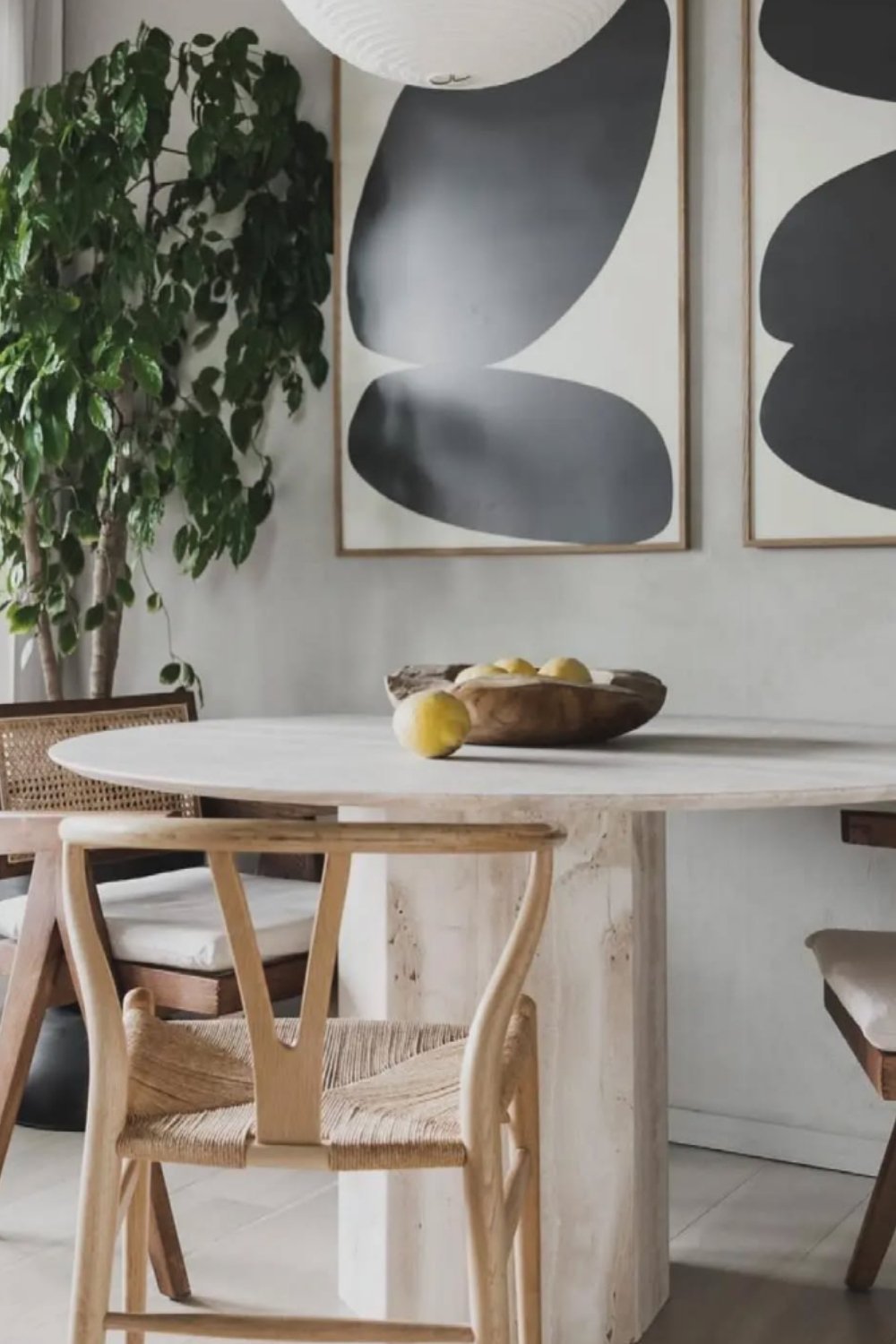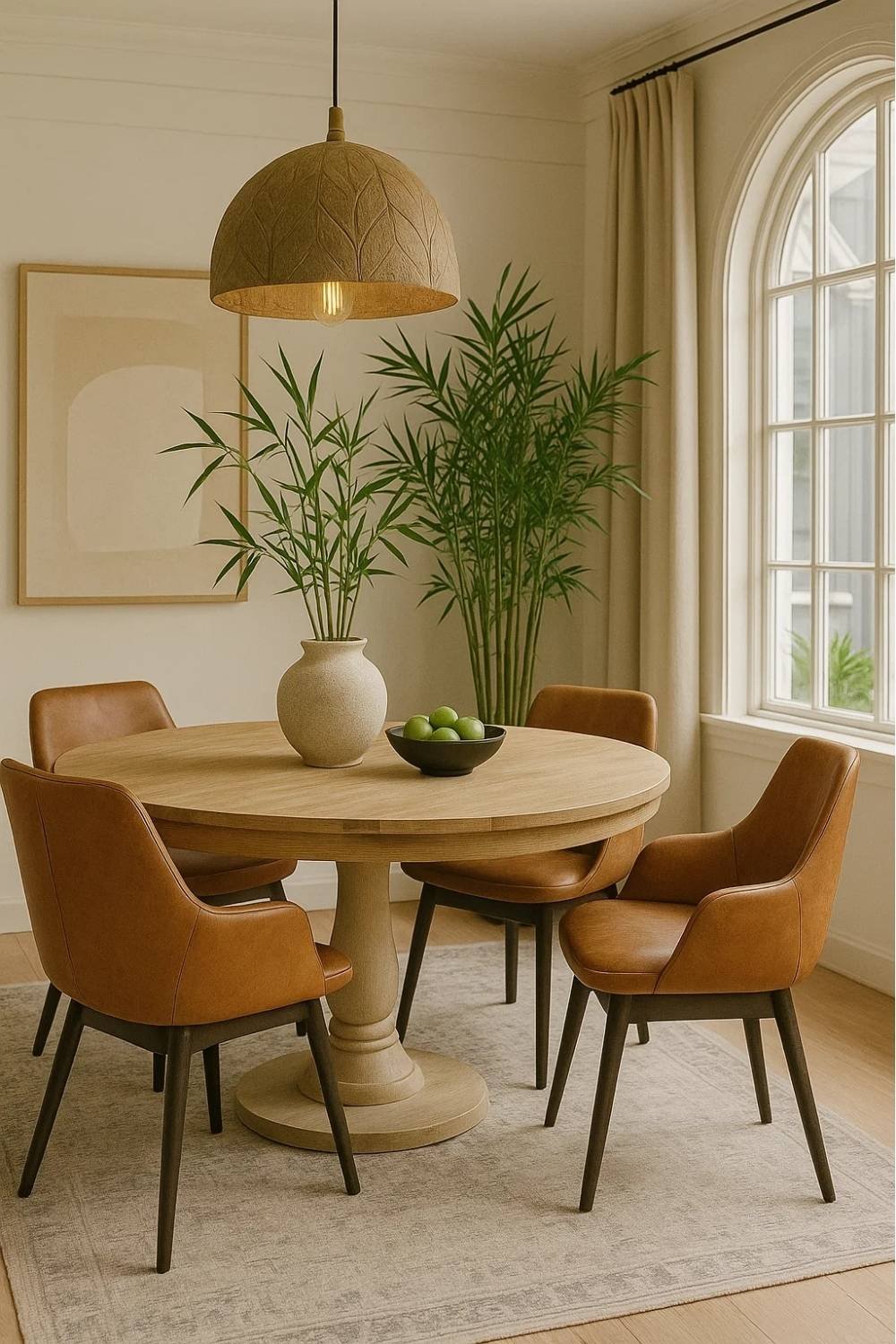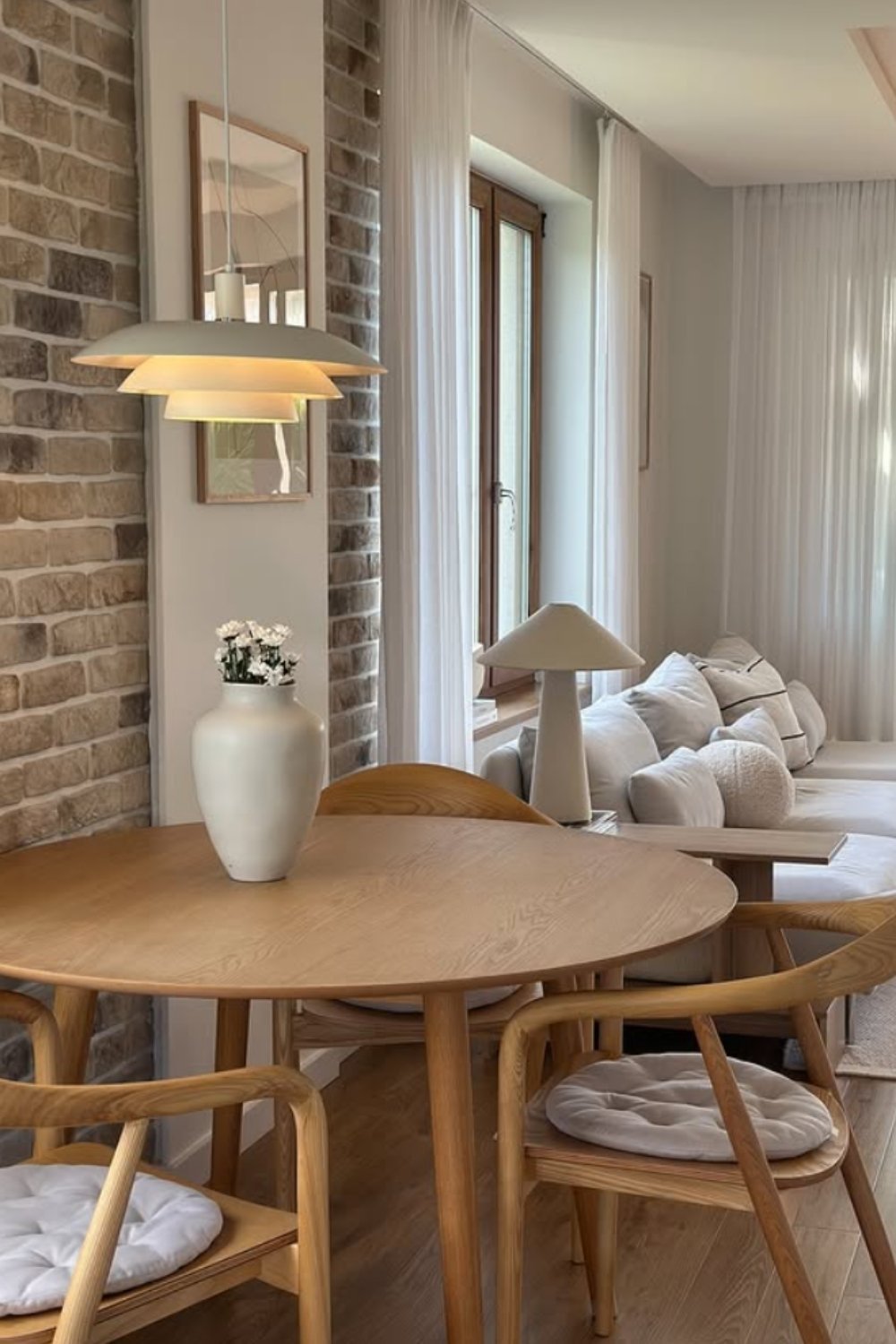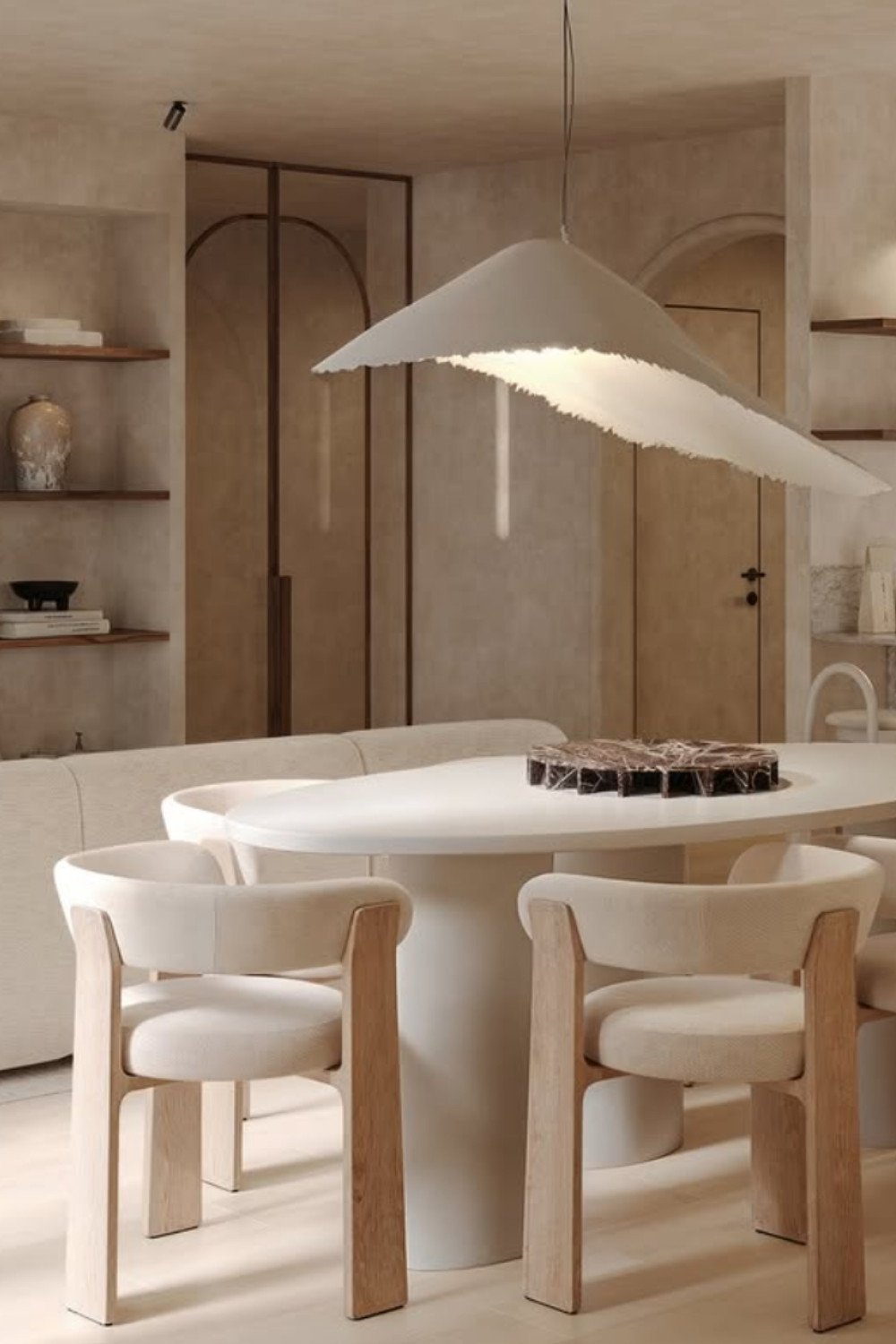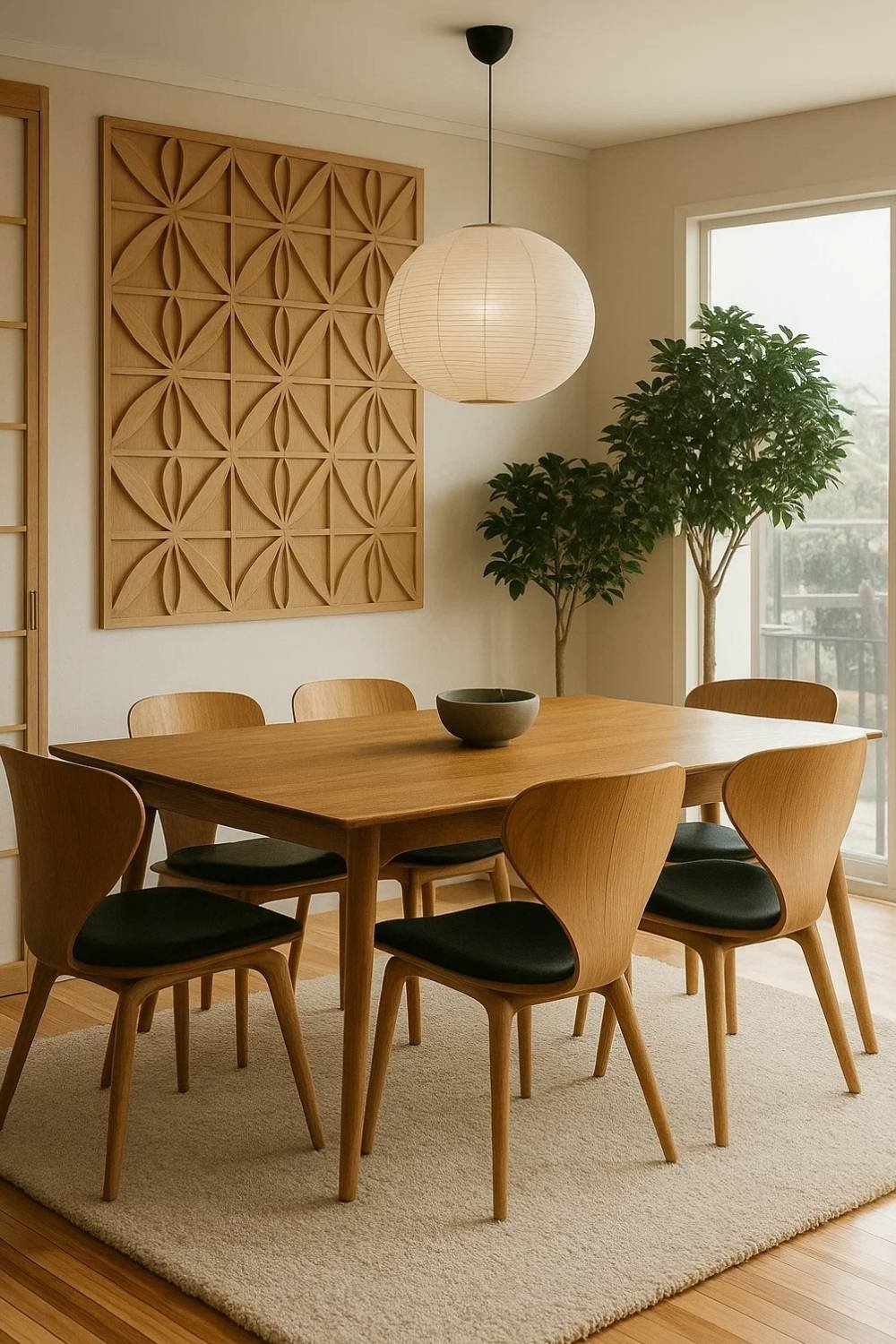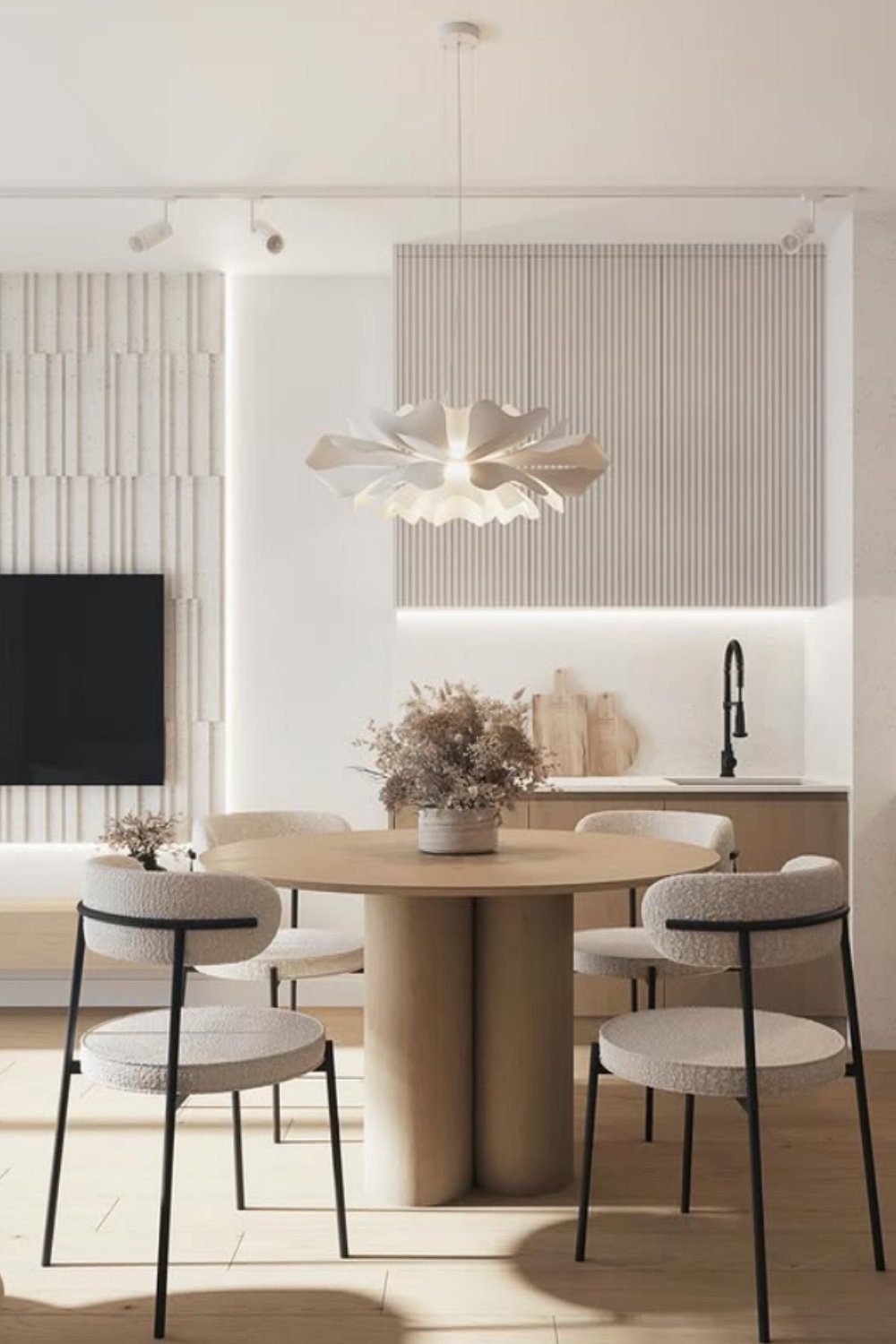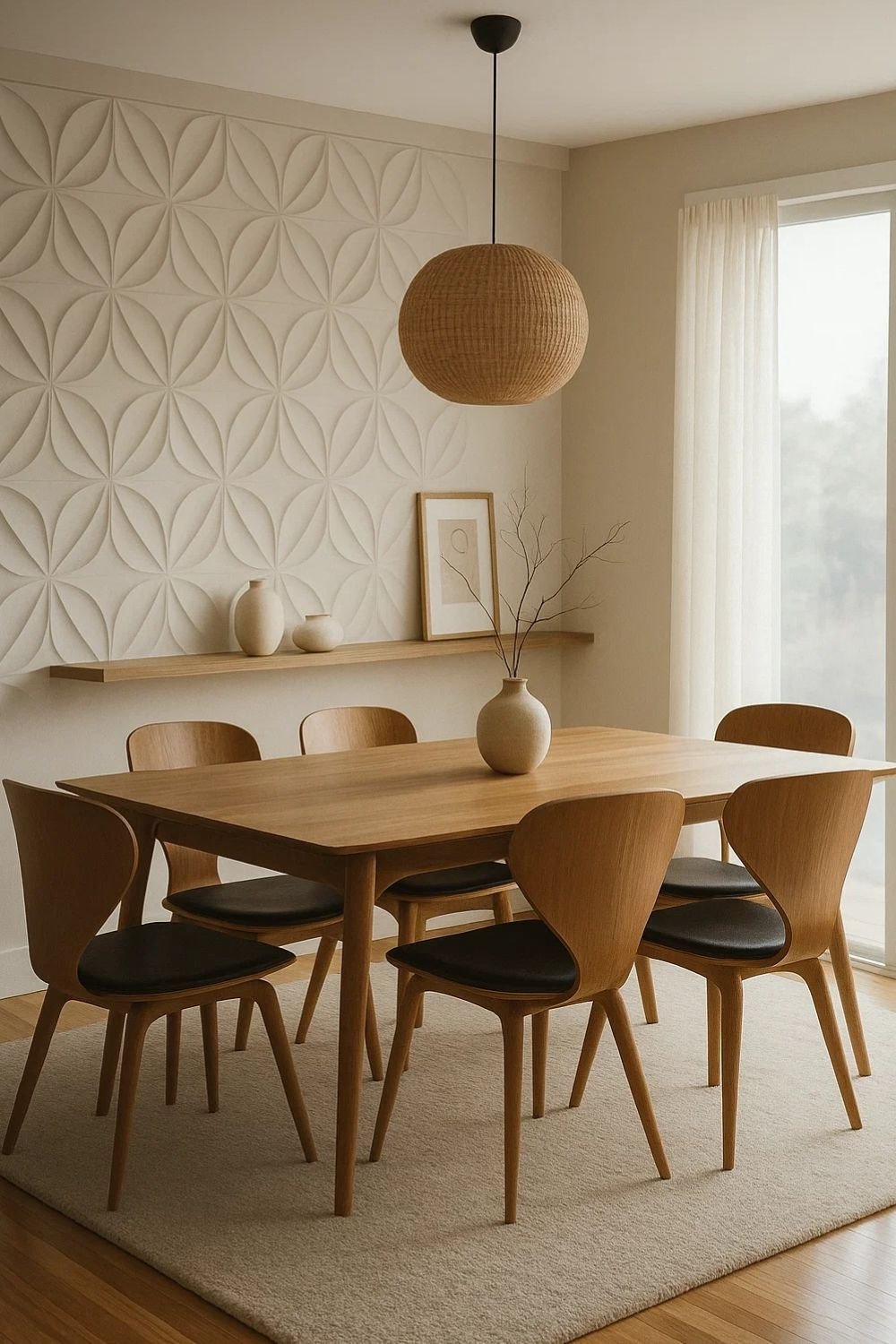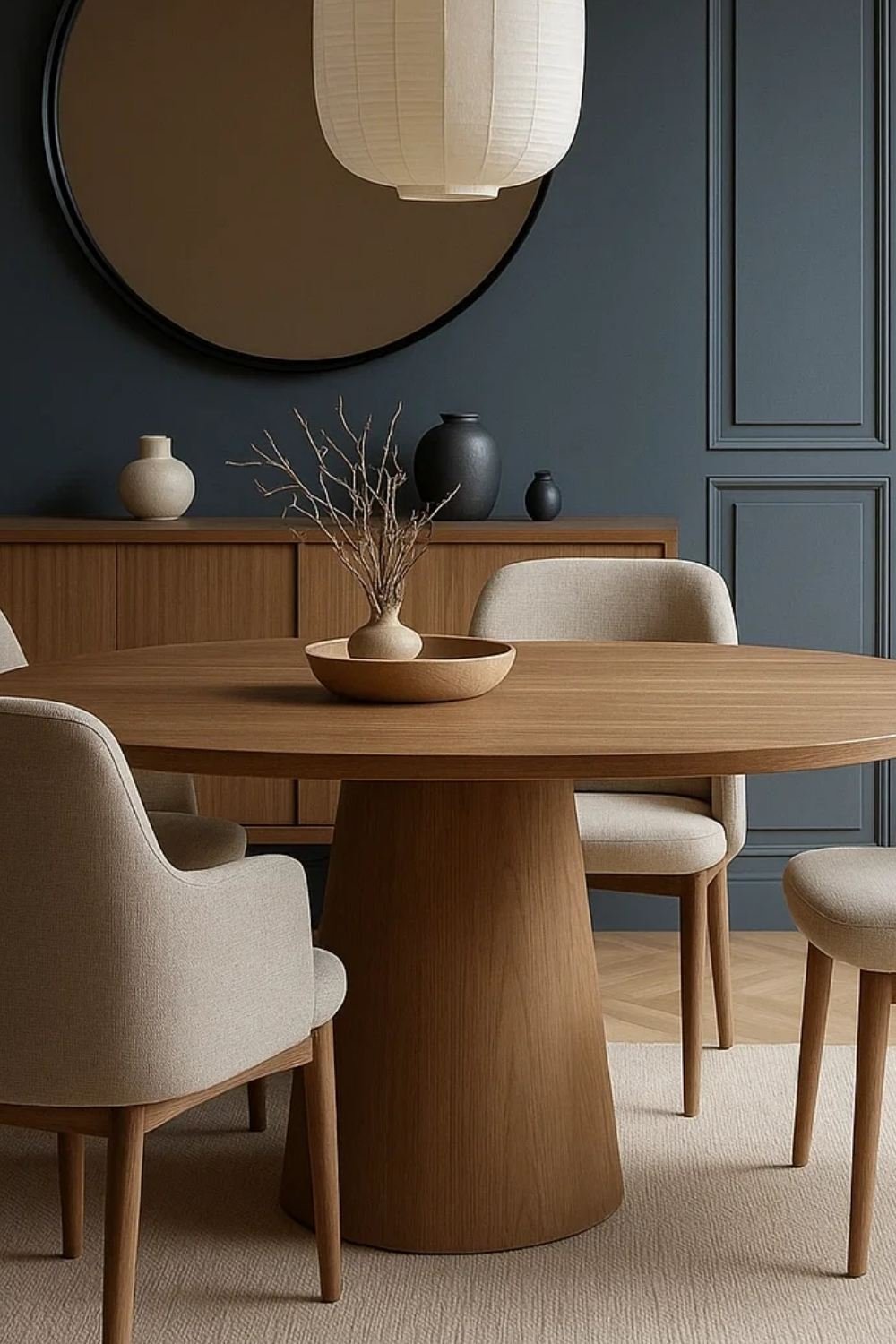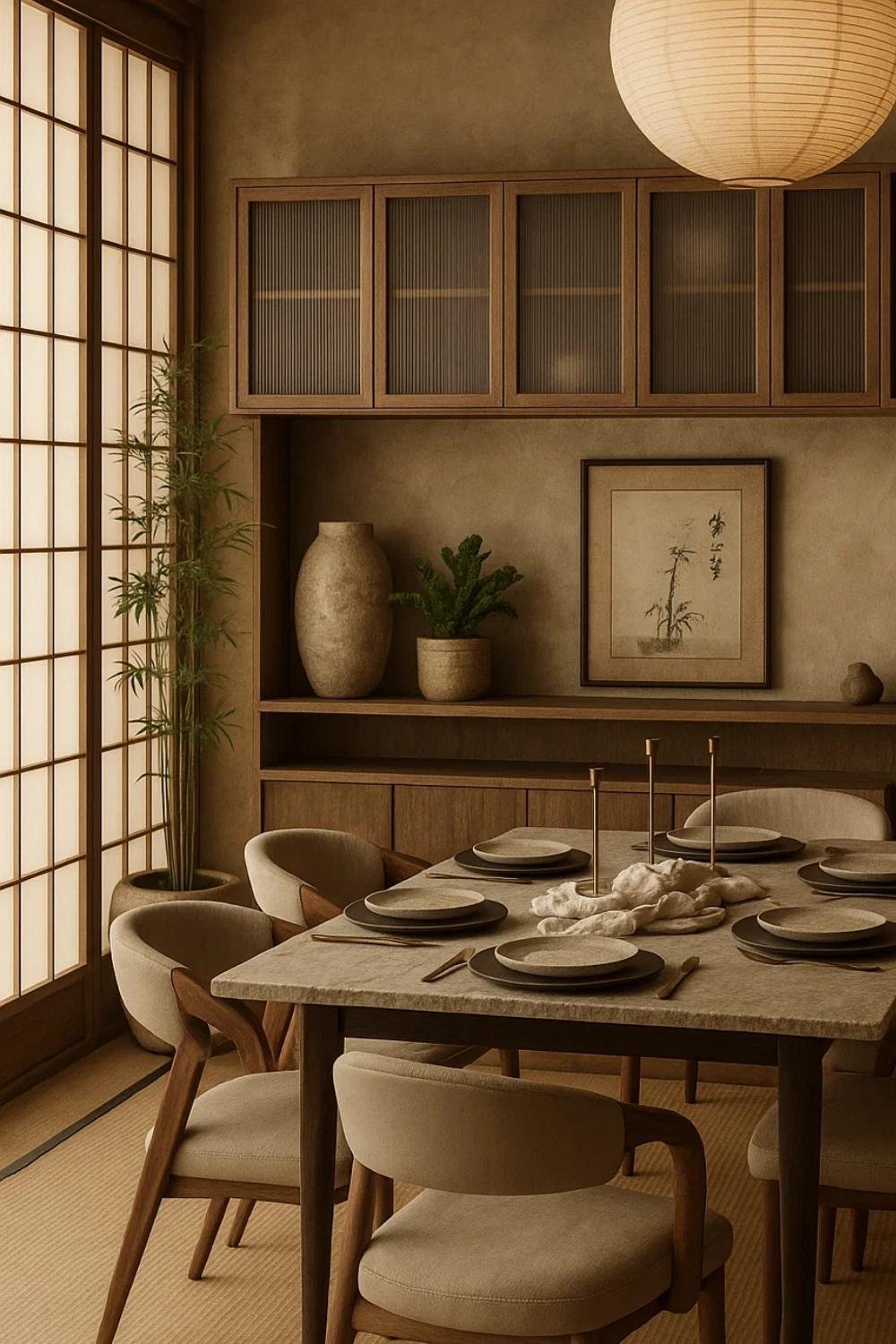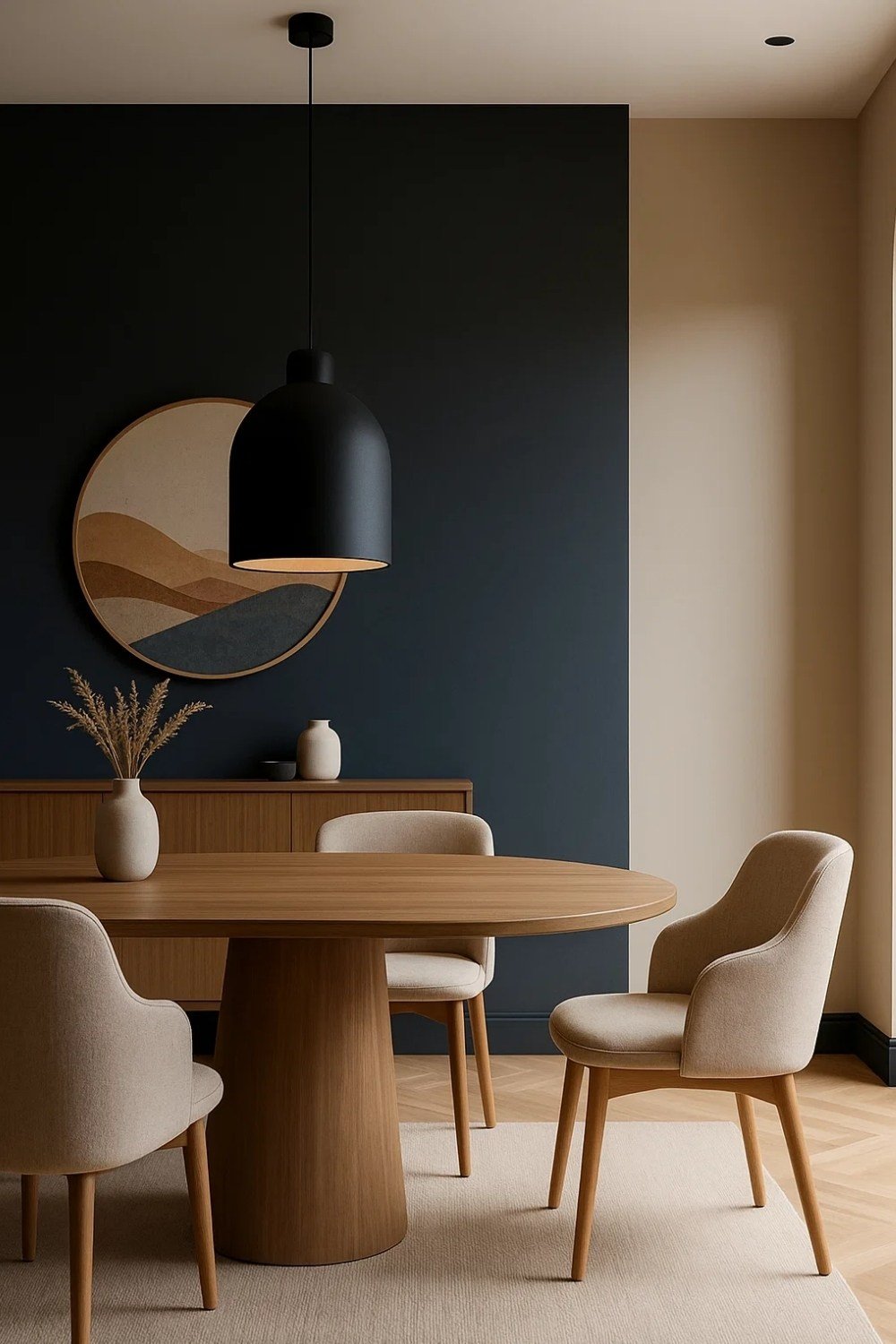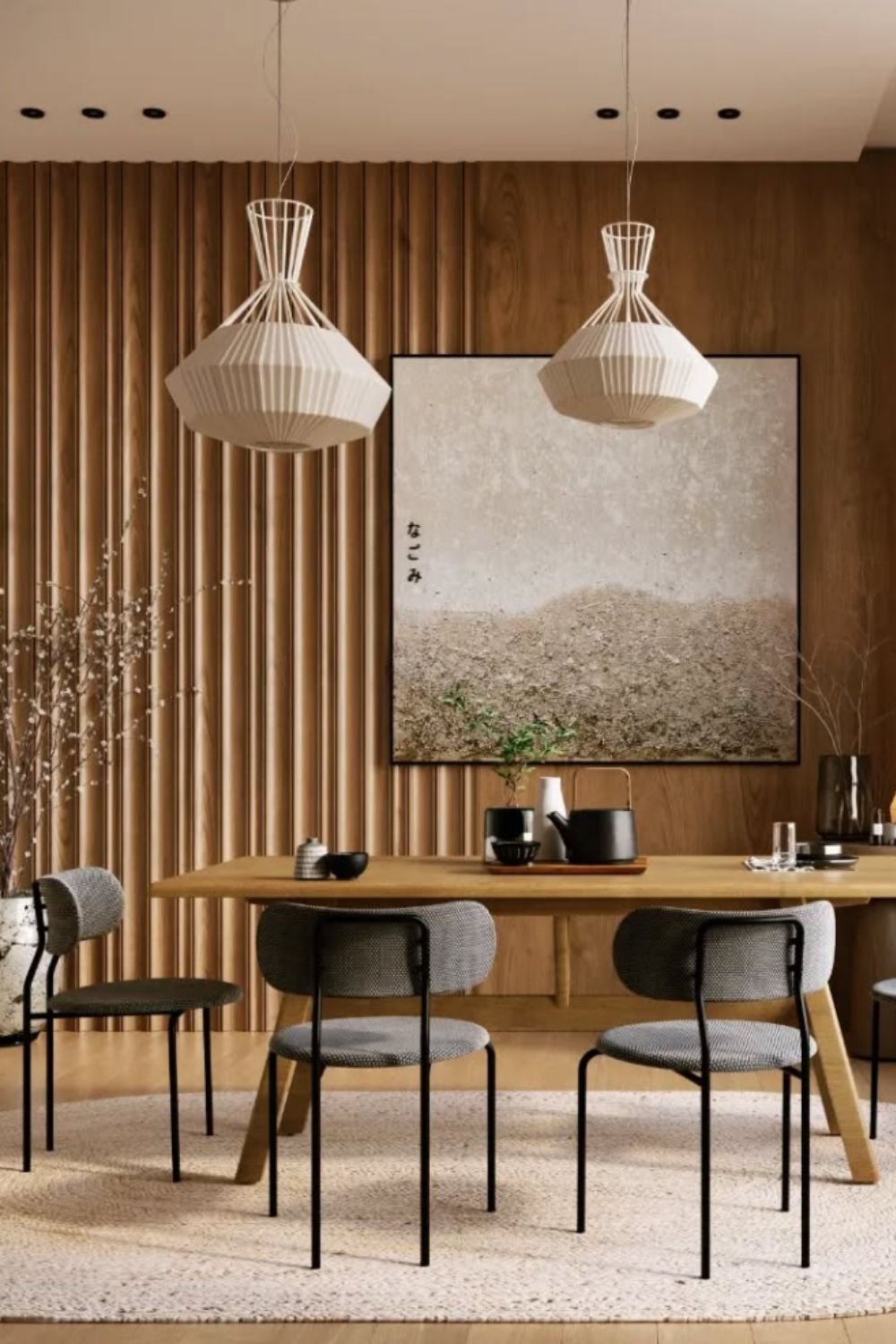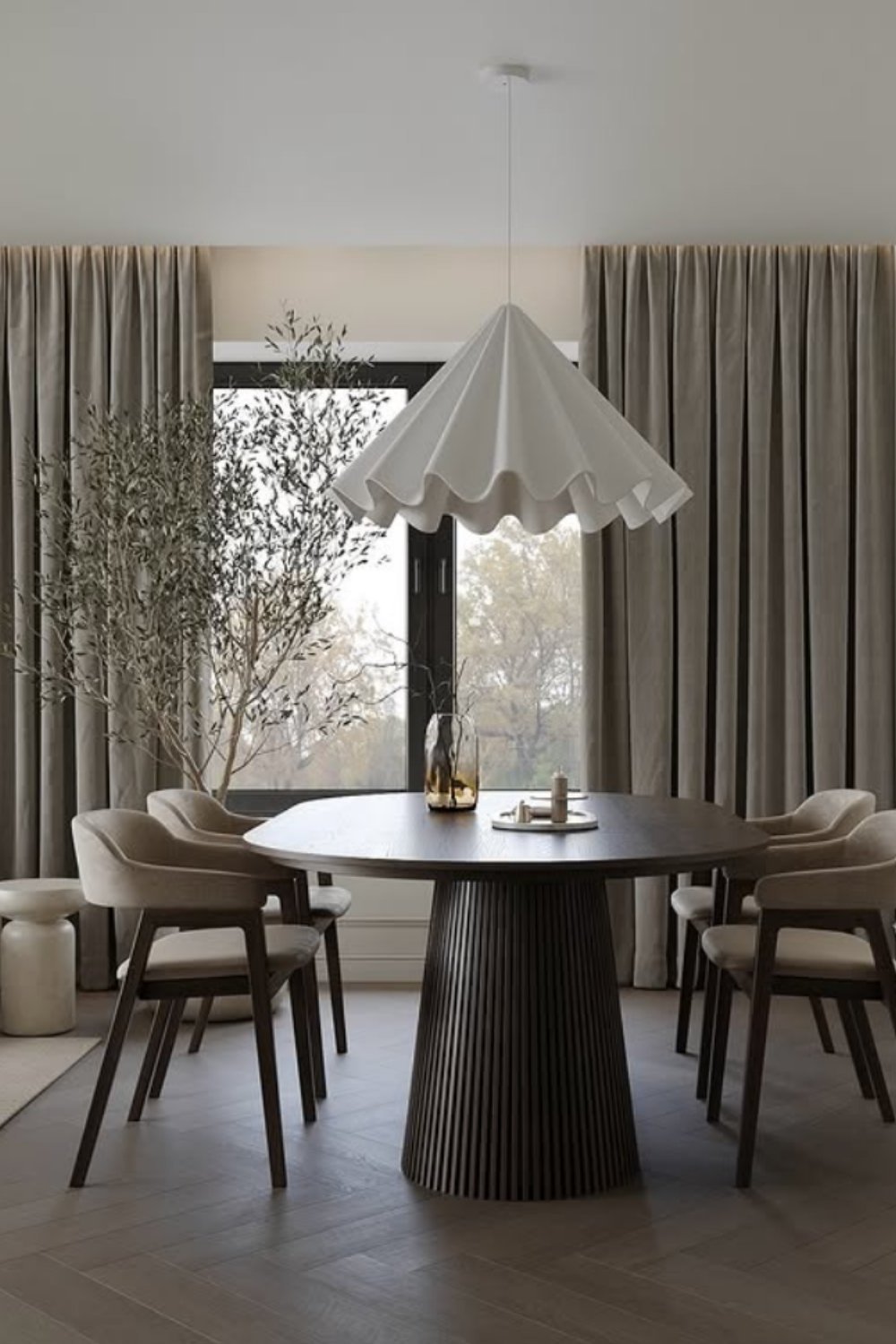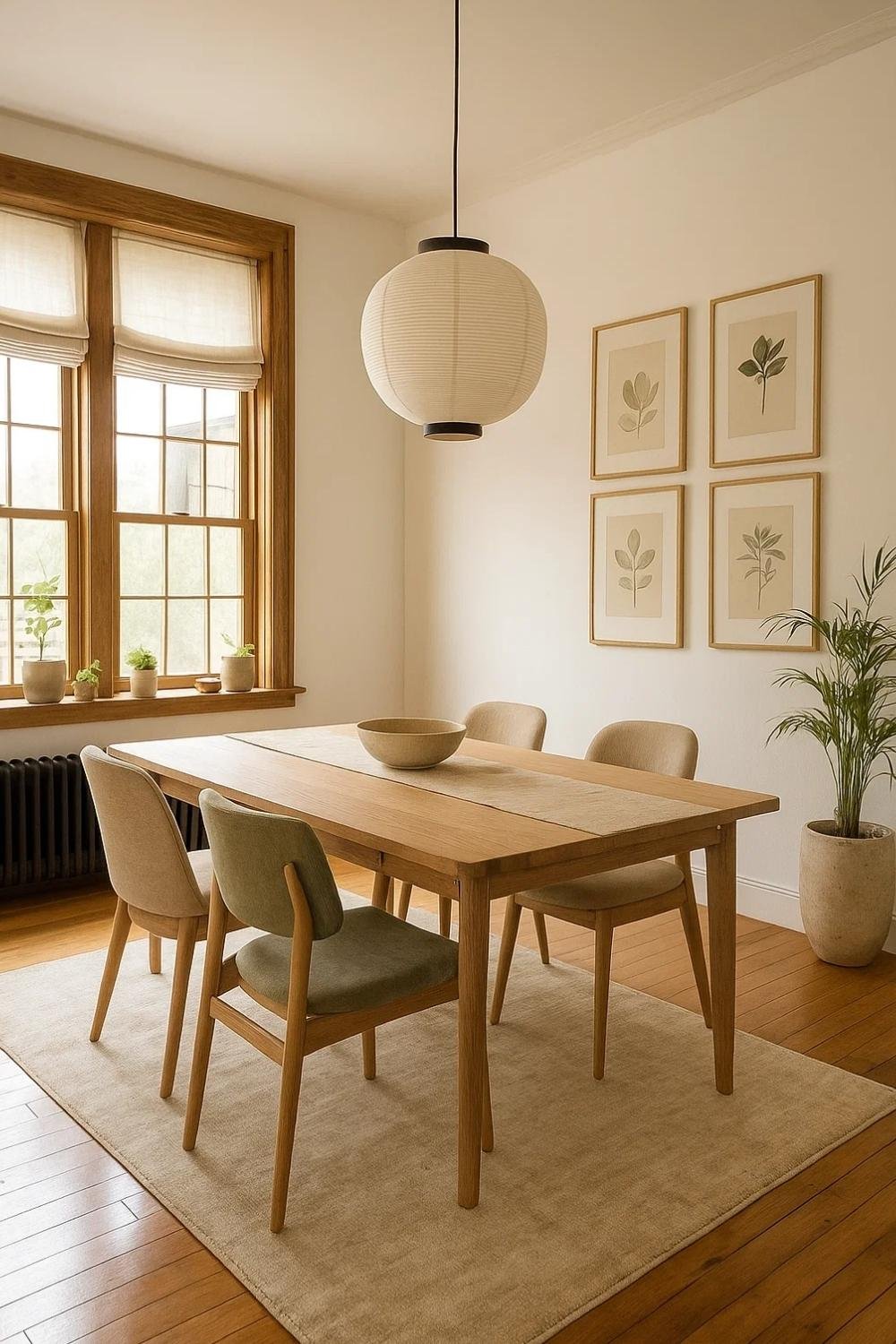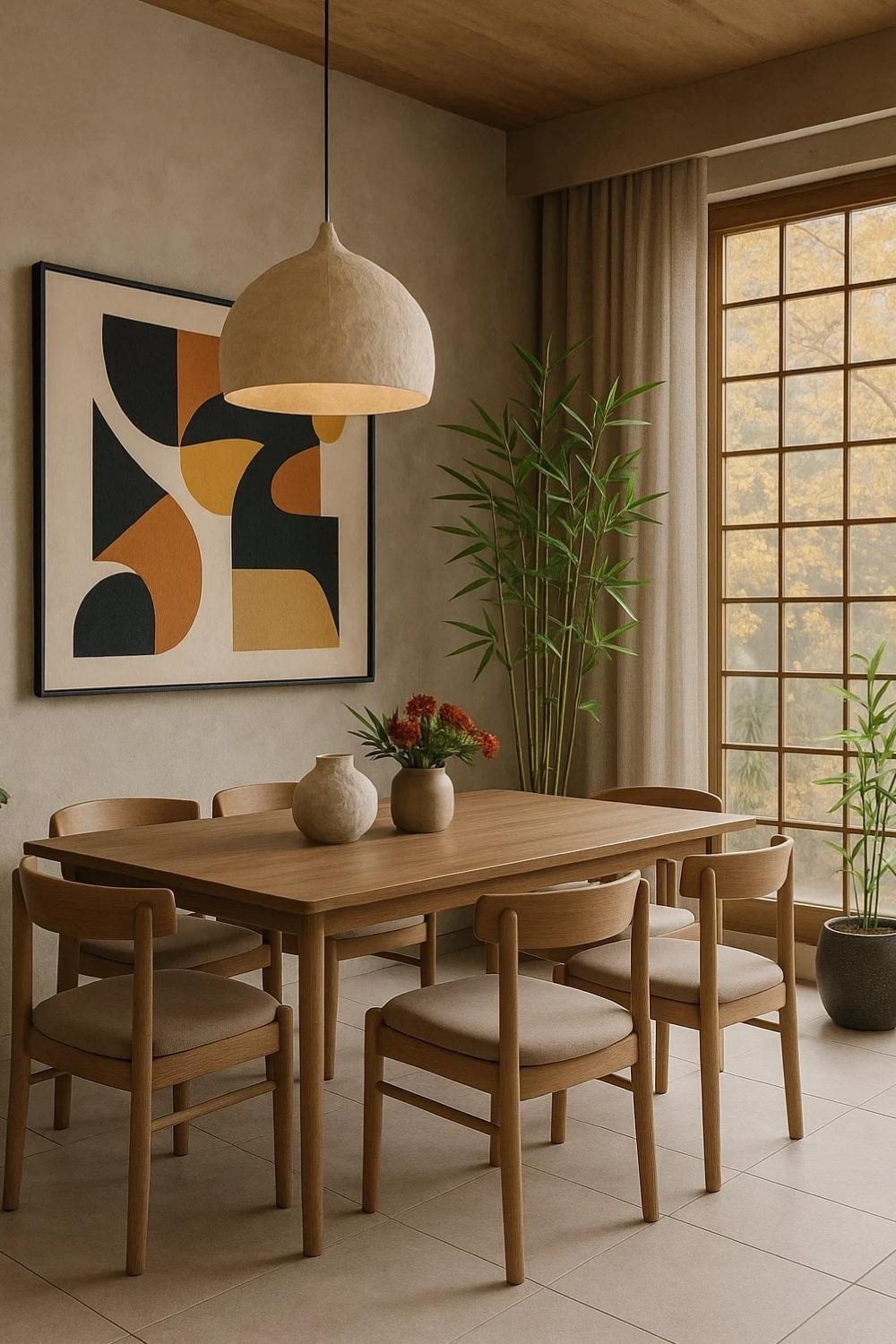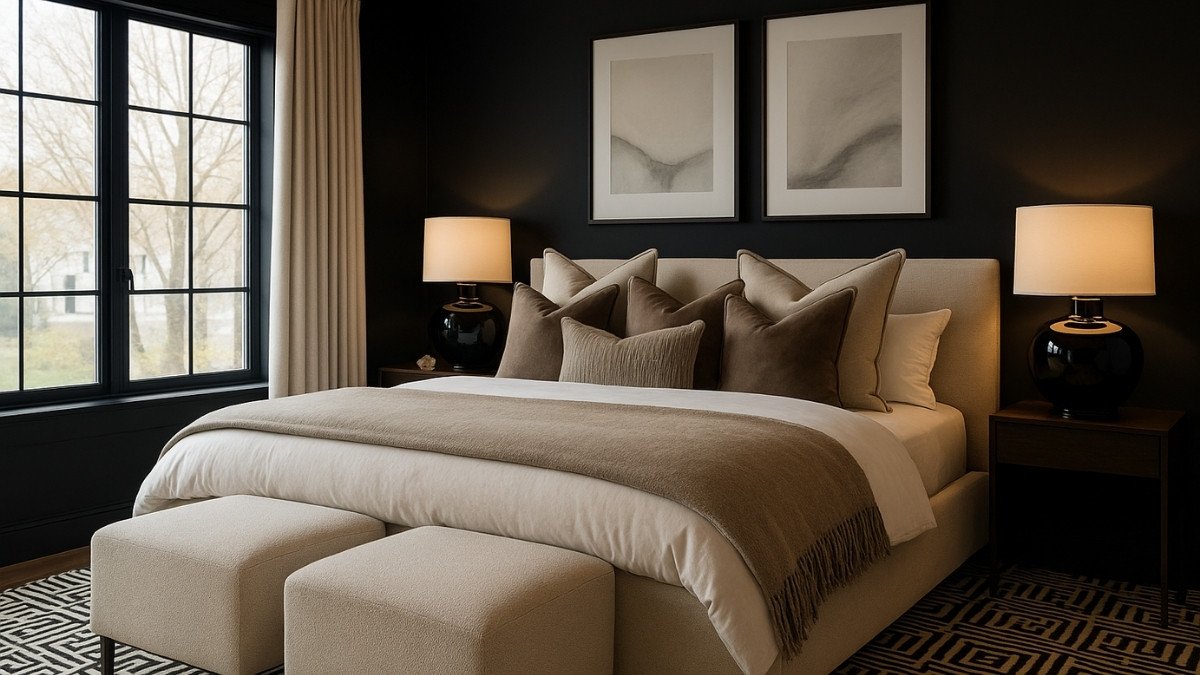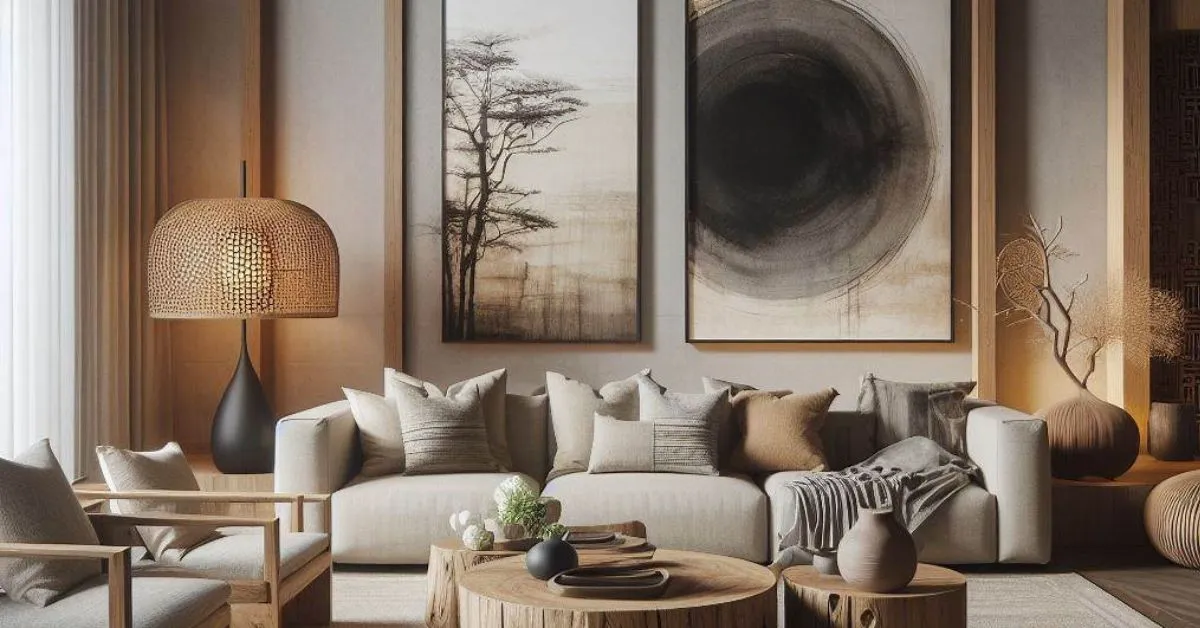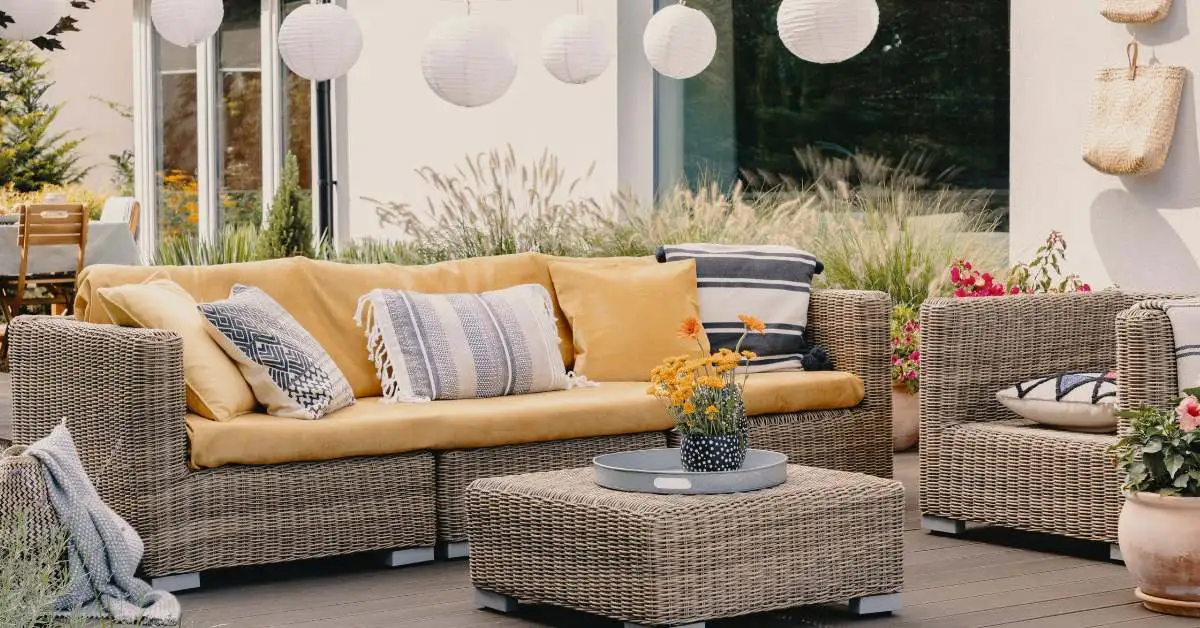Japandi dining room design is all about serenity. These spaces aren’t just styled to look beautiful—they’re created to bring calm, order, and a deeper connection to nature. With natural woods, muted color palettes, and thoughtful flow, every meal feels more intentional. Whether you’re drawn to the tradition of tatami seating or the clean lines of modern minimalism, Japandi shows how restraint and beauty can exist in perfect harmony.
Other Posts You’ll Love:
- 12+ Unique Coffee Station Ideas to Inspire You
- Japandi Interior Design Style: Unlock the Secrets
- Escape Chaos: How to find Your Personal Interior Design Style
Here are 23 inspiring ways to bring this philosophy into your dining space.
1. Light-Filled Balance with Wooden Simplicity
Calm comes through balance here. Pale wood flooring and furniture set a warm foundation, while a paper lantern softens the daylight. Built-in cabinetry keeps the look clean, and a simple plant or ceramic piece adds just enough detail without breaking the flow.
2. Warm Ambience in Japanese Dining Room Design
Japanese dining room design here thrives on atmosphere. Dark wood grounds the space, while glowing lanterns add rhythm and warmth. Greenery and simple wall art complete the cocoon-like feel, turning the table into the true heart of the room.
Expert Tip for Japandi Dining Room Design:
✅ Start With Natural Foundations Choose wood, bamboo, linen, and stone as your primary materials. These textures are timeless and instantly ground the space.
3. Modern Minimalism With Sculptural Accents
This space reimagines Japanese aesthetics with a modern touch. A simple wood table pairs with sculptural stools, while tatami flooring and a single lantern keep the palette soft. Minimal accessories let the natural textures and balanced forms take center stage.
4. Traditional Japanese Dining Room Design With Tatami
This japandi dining room captures the roots of Japanese dining culture. A low wooden table sits directly over tatami mats, surrounded by dark floor cushions that invite communal meals at ground level. Shoji screens filter daylight, creating a layered play of light and shadow. This design encapsulates the essence of Japanese dining room design—uncluttered, harmonious, and deeply connected to tradition.
Expert Tip for Japandi Dining Room Design:
✅ Respect Negative Space Don’t fill every corner—allow the room to breathe. Empty areas create calm and emphasize what’s truly important.
5. Artistic Walls in Japanese Dining Room Design
Image By: olivin__
This dining room elevates simplicity with a mural-like wall that references nature in a subtle, artistic way. Light wood chairs and a simple table keep the atmosphere grounded, while the woven pendant lamp adds warmth and tactility. The overall look balances restraint with a quiet statement, showing how Japanese dining room design can incorporate art without breaking minimalism.
6. Monochrome Elegance With Curved Lines
The sixth idea takes a softer, modern approach. A round dining table is paired with curved black chairs, creating contrast against the beige backdrop. Twin pendant lamps float overhead like paper lanterns, offering diffused light. The space feels serene yet contemporary—proof that Japanese minimalism adapts beautifully to modern palettes.
7. Sculptural Dining Table as a Centerpiece
Image By: japandihouse_official
In this space, the table itself becomes the star. The sculptural wooden base adds movement and interest, while the chairs remain understated. Neutral walls and shelving keep the room calm, letting the natural wood tones take center stage. This approach reminds us that in Japanese-inspired design, one strong focal point is often enough.
8. Light Neutrals for a Soft Japanese Dining Room Design
Image By: manieke
This japandi dining room shows how layering textures can replace layering colors. Whitewashed walls, pale flooring, and light-toned chairs create a space that feels airy and timeless. A pendant light anchors the table while built-in shelving blends seamlessly into the backdrop. This is Japanese dining room design distilled to its softest expression—elegant, pure, and calm.
Expert Tip for Japandi Dining Room Design:
✅ Add Living Elements Even one bonsai, ikebana arrangement, or indoor tree can shift the mood, keeping the connection with nature alive.
9. Organic Wood With Minimal Accessories
Image By: tamarliving
Here, a solid wood table with a natural, organic edge defines the dining area. The surrounding chairs are upholstered in simple beige fabric, ensuring comfort without clutter. A linear pendant above the table adds a modern touch, while a single indoor tree keeps the connection to nature alive. The design feels raw yet refined.
10. Modern Japanese Dining With Abstract Accents
Image By: jsinterior.design
The tenth idea mixes minimalism with personality. A round dining table in pale wood is paired with sculpted chairs, while bold black-and-white abstract artwork adds just the right amount of contrast. The greenery and natural textures prevent the room from feeling stark, proving that even bold accents can exist peacefully in a Japanese-inspired setting.
11. Earthy Warmth With Natural Light
This dining space shows how natural light transforms a room. A round wooden table sits under a woven pendant, accompanied by upholstered chairs in earthy tones. Large windows flood the space with light, highlighting the greenery placed nearby. The result is warm, fresh, and deeply connected to the seasons.
12. Cozy Minimalism With Brick Texture
Image By: _agnesshome
The final space in this set embraces a slightly rustic edge. A simple wooden table and chairs sit against an exposed brick wall, adding tactile interest without disrupting harmony. A sleek pendant lamp offers soft illumination, while neutral drapes filter daylight gently. This blend of natural materials demonstrates how Japanese calm can merge seamlessly with modern urban interiors.
13. Minimal Monochrome Elegance
Image By: sophisticated_livings
This design shows how a dining room can feel elevated with a simple monochrome palette. A sculptural pendant floats above a white dining table and matching chairs, creating an airy yet refined look. Natural textures—like the matte wall finishes—add warmth and prevent the space from feeling stark. It’s a reminder that minimalism can still feel soft when grounded in texture.
14. Mid-Century Flair in Japanese Dining Room Design
Here, mid-century curves blend beautifully into Japanese dining room design. The warm wood tones of the table and chairs are softened by a large paper lantern and a natural woven rug underfoot. A geometric wood wall panel provides texture without overwhelming the space, while greenery adds a living, organic touch. This balance of past and present shows how Japanese minimalism adapts seamlessly across styles.
Expert Tip for Japandi Dining Room Design:
Use paper lanterns, soft pendants, and floor lamps to create a gentle rhythm of light rather than relying on harsh overheads.
15. Contemporary Neutral Dining With Sculptural Lighting
Image By: ondesign_studio
In this room, the dining table is circular and minimalist, surrounded by sleek chairs in contrasting tones. The standout feature is the sculptural pendant, which hangs delicately above and becomes an art piece in itself. Neutral walls and soft daylight give the room a refined, gallery-like feel—perfect for modern homes inspired by Japanese calm.
16. Balanced Japanese Dining Room Design With Warm Texture
The final look in this set embodies balance. A wooden dining table and mid-century style chairs are grounded by a woven pendant and a textured rug. The patterned feature wall adds depth, while still keeping the palette restrained and natural. This is Japanese dining room design at its most inviting—calm, tactile, and effortlessly harmonious.
17. Deep Contrast and Natural Warmth
This dining room shows how darker tones can still feel serene when balanced with wood. A deep navy wall creates a striking backdrop for the round wooden table and soft upholstered chairs. The circular mirror adds depth while keeping the flow harmonious, making the space dramatic yet calming.
18. Traditional Japanese Dining Room Design With Shoji Screens
Here, the dining space leans into tradition. Wooden cabinetry, tatami-inspired textures, and shoji screens bring authenticity, while a low round table grounds the setting. A single lantern pendant completes the mood. This is a timeless example of Japanese dining room design, where every element feels intentional and tied to heritage.
19. Minimalist Drama With Black Accents
The nineteenth room uses contrast with restraint. A black pendant lamp hangs over a round wooden table, while a navy accent wall highlights the curved forms of the chairs. The design is pared back but strong, showing how a few bold touches can make a Japanese-inspired dining space feel fresh.
20. Contemporary Japanese Dining Room Design With Vertical Wood
Image By: phasecraft_designs
This space celebrates rhythm and texture. Vertical wooden slats line the wall, echoing natural order, while woven pendants bring warmth overhead. A round dining table anchors the room, surrounded by sleek black chairs. This is Japanese dining room design with a contemporary edge—calm, balanced, yet dynamic.
21. Sculptural Pendant With Neutral Palette
Image By: tok_architektura
The twenty-first dining room leans into sculptural design. A pleated pendant hangs above a circular table with a dark base, while muted curtains soften the backdrop. Natural light completes the look, creating a room that feels both modern and serene.
Expert Tip for Japandi Dining Room Design:
✅ Choose Functional Beauty Opt for handcrafted ceramics, woven accents, or calligraphy scrolls that serve a purpose but also bring quiet artistry.
22. Timeless Japanese Dining Room Design With Classic Simplicity
This design proves that simplicity never fades. A rectangular wooden table and mid-century style chairs sit on a neutral rug, with soft wall art adding just the right amount of detail. A paper lantern overhead ties the look together. It’s a perfect example of Japanese dining room design done with timeless elegance.
23. Natural Materials and Modern Art
In this room, natural wood tones are paired with a bold piece of abstract art. The dining table and chairs are simple and functional, while the greenery in the corner connects the room to nature. This design strikes a balance between contemporary character and Japanese-inspired calm.
Cozy Haven Tales Pro Tips for Lasting Serenity:
🌿 Seasonal Switches: Keep your base neutral so you can refresh with seasonal accents like greenery in spring, dried branches in autumn, or candlelight in winter.
🌿 Mix Tradition and Modernity: Don’t be afraid to pair shoji-inspired screens with sleek contemporary chairs—Japanese design thrives on harmony, not uniformity.
🌿 Stay Minimal, Stay Mindful: Before adding anything, ask if it contributes to calm. If not, let it go.
🌿 Invest in Quality: Fewer, better pieces—like a solid wood table or artisan lighting—make the room feel intentional and enduring.
🌿 Flow Matters: Ensure your dining room connects smoothly with adjacent spaces, keeping movement open and unforced.pro n expert do I need separate titles.
Wrapping Up: Your Cozy Haven
Designing a dining space in the spirit of Japanese interiors isn’t about replicating tradition—it’s about capturing the feeling of calm. Through natural textures, restrained palettes, and mindful choices, your dining room can become more than a place to eat; it becomes a sanctuary where every meal feels intentional.
The beauty of Japanese dining room design lies in its adaptability. From tatami-style traditions to sleek modern interpretations, the guiding principles remain the same: simplicity, harmony, and connection to nature.
By applying these ideas with care, you’ll create not just a dining room, but a cozy haven—one that supports slower living, deeper connections, and everyday serenity.
FAQs on Japanese Dining Room Design
Natural materials, neutral palettes, soft lighting, and uncluttered spaces form the foundation of Japanese dining interiors.
Not necessarily—tatami mats are traditional, but you can use natural fibre rugs or wooden flooring to achieve a similar calm, grounded effect.
Stick to neutral and earthy tones—warm beiges, soft greys, light browns, and creamy whites, with touches of black for balance.
Use soft, diffused lighting such as paper lanterns, linen pendants, or layered floor and wall lamps instead of harsh overhead fixtures.
Yes—modern pieces with clean lines and natural materials integrate beautifully, as long as the space feels uncluttered and harmonious.
Low wooden tables with floor cushions are traditional, but minimalist wooden chairs or benches also work well for a contemporary look.
Simple touches like bonsai trees, ikebana flower arrangements, or even potted greenery connect the indoors to the natural world.
Absolutely—its minimalist approach, emphasis on flow, and clever use of natural light make it perfect for compact dining areas.
